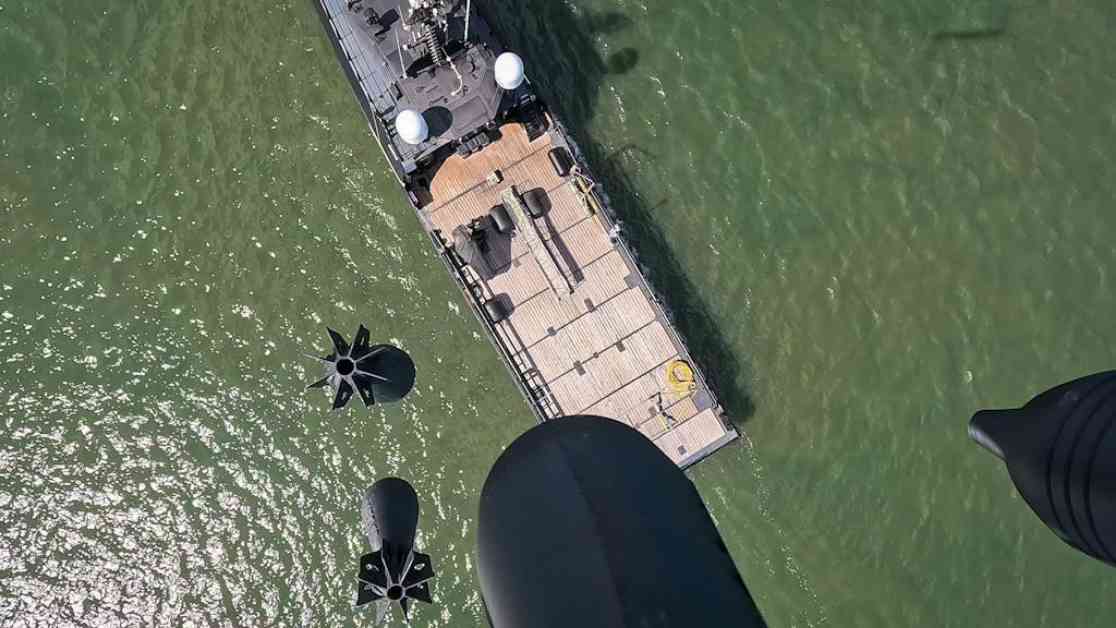Drone Strikes Royal Navy Ship in Groundbreaking Military Exercise
In a groundbreaking display of technological advancement, a drone recently conducted a simulated bombing on the Royal Navy’s experimental vessel, XV Patrick Blackett. The incident occurred during the uncrewed systems training exercise REPMUS24, which was held off the coast of Portugal. This demonstration showcased the Royal Navy’s utilization of autonomous systems in military exercises, pushing the boundaries of cutting-edge technology.
The UAV Rotron drone’s successful artificial bomb drop marks a significant milestone in the development of autonomous warfare capabilities. The Royal Navy’s experimentation with uncrewed systems is a crucial step towards enhancing their operational effectiveness and maintaining a strategic edge in modern warfare. This event not only highlighted the Navy’s commitment to innovation but also demonstrated their readiness to adapt to the evolving landscape of military technology.
International Collaboration and Technological Integration
Personnel from 27 nations, including the UK, actively participated in the REPMUS24 exercise, emphasizing the importance of international collaboration in advancing military technology. The event served as a platform for testing and integrating various uncrewed systems into operational task groups, fostering a spirit of cooperation and knowledge sharing among participating countries.
The annual REPMUS exercise, organized by NATO, focuses on advancing uncrewed systems and promoting technological innovation in maritime operations. XV Patrick Blackett, the Royal Navy’s designated testbed for new maritime technologies, played a central role in the trials, showcasing the Navy’s dedication to exploring the capabilities of autonomous systems in a controlled environment. The successful integration of a wide range of uncrewed systems, including mini quadcopters, surveillance drones, and autonomous Pacific 24 ribs, underscored the Navy’s commitment to embracing emerging technologies.
Advancements in Uncrewed Aerial Vehicles and Military Operations
Building on the success of previous exercises, the Royal Navy tested a variety of uncrewed aerial vehicles during REPMUS24, including the Peregrine, Puma, and Ebee Vision drones. These drones played a crucial role in enhancing situational awareness, reconnaissance capabilities, and target acquisition, showcasing the potential for unmanned aircraft to revolutionize military operations. The Navy’s use of NavyPODS, specialized shipping containers serving as operations rooms, command centers, and storage facilities for uncrewed systems, further highlighted their dedication to streamlining logistics and operational efficiency.
The REPMUS24 exercise also contributed to progress under the AUKUS agreement, a strategic defense and security partnership between the UK, Australia, and the United States. Through collaborative efforts like REPMUS24, NATO and its allies aim to refine and test emerging autonomous technologies to bolster their collective defense capabilities and ensure readiness for future military challenges. The exercise served as a testament to the commitment of allied nations to fostering innovation and technological integration in military operations.
The successful demonstration of the drone’s bombing capabilities on the Royal Navy’s XV Patrick Blackett vessel signifies a significant leap forward in the realm of autonomous warfare. This event not only highlights the Navy’s commitment to embracing cutting-edge technologies but also underscores the importance of international collaboration in advancing military capabilities. As the Navy continues to explore the potential of uncrewed systems in operational scenarios, the lessons learned from exercises like REPMUS24 will undoubtedly shape the future of maritime warfare.

